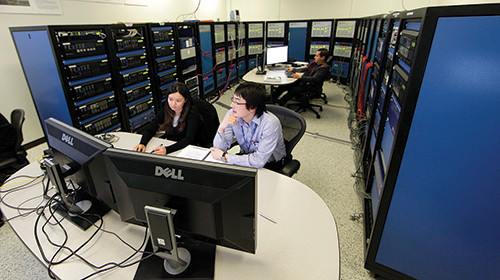Faced with increasingly complex technology and a shift toward deregulation in the power market, today’s electric utilities are under unprecedented pressure to improve the quality, reliability, security, and cost of the power that they supply to their customers. Real time digital simulators are a critical tool for utilities in this demanding and dynamic environment. For over two decades, utilities have used real time digital simulation to support their efforts in the study of power systems and their operation, the closed-loop testing of new equipment, and the strategic development of new protection and control schemes.
Before digital simulation was developed, analogue simulators were used to study electrical power systems and to test physical protection and control equipment. Analogue simulators were composed of scaled-down physical models of power system components, and inherently operated in real time. Although they were important tools at the time, particularly in the development and testing of HVDC and FACTS controls, they did have several drawbacks. The limited size and complexity of the network representation, as well as the high initial and operating costs, were among the disadvantages of this technology.
In the late 1980s, the available computer technology and modeling techniques made it possible to develop a digital simulation platform that operated in real time. Real time digital simulators emerged, combining the flexibility and accuracy of digital simulation with the inherent ability of analogue simulators to perform closed-loop testing of physical protection and control devices. Today, digital power system simulation technology has seen immense growth in the capabilities of computer processors, the sophistication and detail of component models, and flexibility in application. The modern digital simulator meets the demands of today’s electric utility, and is capable of a huge range of applications, including renewable energy integration, protection testing via IEC 61850 communication, the implementation of wide-area measurement schemes using phasor measurement units, HVDC and FACTS scheme testing involving modular multi-level converters, exciter control testing and tuning, operator training, and black start studies, among others. This article will explore specific examples of these applications and how they’re reducing system downtime, preventing equipment damage, and building a more favourable reputation for electric utilities around the world.
China Southern Grid (CSG), one of China’s largest electric utilities, owns and operates the world’s largest real time digital simulator, which is used for representing their AC-DC parallel transmission network. Using simulation technology, CSG is able to represent their entire transmission network above 220kV, including 8 HVDC systems, 1100 three-phase power system buses, 1400 transmission lines, and over 250 generators. Their state-of-the-art simulation laboratory combines simulation hardware and software with numerous sets of HVDC protection and control devices, which can be interfaced with the digital simulator in a closed loop.
The main applications of CSG’s digital simulator are power grid operation analysis, system stability control testing, and the dynamic performance testing of HVDC projects. Dynamic performance testing involves the thorough testing of new HVDC projects before the technology is dispatched in the network. In 2013, CSG developed an interface between simulated modular multi-level converters and a physical control scheme in their laboratory. CSG’s power dispatch department uses the simulation results to adjust system operation on a continual basis. To this end, CSG’s simulator deals with many tasks related to power grid dispatching, including pivotal stability risk verification, failure analysis, and the determination of system operating strategy.
In the winter of 2008, southern China experienced a major ice storm which caused extensive damage to CSG’s network, resulting in over 7,000 lines damaged and millions of customers without power. During this process, CSG’s engineers used a real time digital simulator to help guide the restoration of their network. Following this, CSG officially identified real time digital simulation as one of their four key strategies for ensuring the security and reliability of their power.
Across the globe, digital power system simulation is an equally important tool to Southern California Edison (SCE), a utility providing power to millions of customers in the western United States. SCE owns and operates a large-scale digital simulator which they use for a wide variety of applications, including the testing of a centralized remedial action scheme, verification of the operation of phasor measurement units, and the closed-loop testing of line protection devices and schemes. The simulation platform at SCE is also used for interfacing to external equipment via various LAN-based communication protocols, and is capable of communicating via IEC 61850-compliant Sampled Values and GOOSE messaging, C37.118 protocol for phasor measurement unit data, as well as via DNP 3.0 and IEC 60870-5- 104 SCADA protocols.

The real time digital simulation facility at Southern California Edison
In Canada, Manitoba Hydro is using digital simulation to study the impact of a third HVDC bipole on the existing transmission grid in Manitoba, and to test the corresponding controls prior to implementation. A physical replica of the controls will be built and physically interfaced with Manitoba Hydro’s digital simulator. In addition to HVDC controls testing, they have used simulation as a tool for testing exciter and stop/start sequence controls for a synchronous condenser, joint VAR controllers for a proposed and an existing generating station, black start generator controls, protective relays with point-on-wave breaker close ability, and transmission line protection schemes. Like the other utilities, Manitoba Hydro has developed detailed models of their electrical grid on their simulator.
Digital simulation is also being used extensively for HVDC scheme development and testing at Transpower, New Zealand’s grid owner and system operator. Transpower made use of a digital simulation platform to verify the design and performance of the New Zealand HVDC Pole 3 upgrade project, commissioned in December 2013. The project replaced old mercury arc valve converters and associated control and protection systems with modern thyristor-based converters. Close to 2,000 unique functional and dynamic performance tests were carried out by Transpower’s team using simulation equipment before commissioning and on-site testing took place. Transpower’s simulation laboratory, like those of many utilities around the world, includes replica controls which are physically interfaced with their simulator.
Since the Pole 3 project was commissioned, Transpower’s real time simulator has been extensively used to resolve issues related to the HVDC control and protection systems before implementing changes on site. For each end of the HVDC link, the replica HVDC control and protection system consists of a measurement system interfaced with outputs from the digital simulator, control and protection for Poles 2 and 3, bipole and station controllers, and a transient fault recorder. The software for all of these controllers was developed to run on both the actual on-site system and the replica system. A single Valve Base Electronics system is also included, which can be configured to work with either terminal, and is used for simulating valve misfiring. Lastly, Transpower’s simulation platform includes LAN networks that emulate the on-site communications networks, making it possible to simulate communication faults between converter stations.
It is clear from these success stories that real time digital simulation technology has undergone significant advancements over the past two decades, evolving from an emerging technology to an industry standard tool that is used by over 100 electric utilities worldwide. Today’s power system simulation technology transcends the traditional applications of closed-loop protection and control system testing and is a powerful tool that can be used for studying the integration of smart grid technology, wide area protection and controls, and renewable energy resources and their controls. As we move forward into a world with an even more complex technological landscape, simulation technology will continue to advance, helping electric utilities achieve reliable and secure operation of the grid of the future.
About the Author
 Kati Sidwall holds a B.Eng in Sustainable and Renewable Energy Engineering from Carleton University in Ottawa. She founded the annual Carleton University Green Energy Symposium in 2010. In 2012, she received the Canadian Solar Industries Association’s Emerging Leader Award for her contributions to the Canadian solar energy industry. She currently serves as a Simulation Specialist at RTDS Technologies Inc. – the world standard for real time digital power system simulation.
Kati Sidwall holds a B.Eng in Sustainable and Renewable Energy Engineering from Carleton University in Ottawa. She founded the annual Carleton University Green Energy Symposium in 2010. In 2012, she received the Canadian Solar Industries Association’s Emerging Leader Award for her contributions to the Canadian solar energy industry. She currently serves as a Simulation Specialist at RTDS Technologies Inc. – the world standard for real time digital power system simulation.







